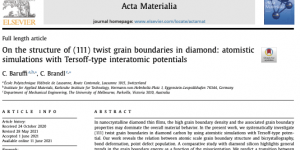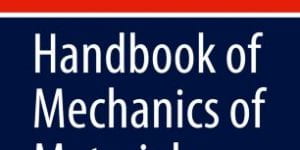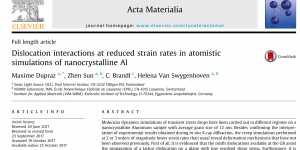 https://doi.org/10.1016/j.actamat.2021.117055 Abstract: In nanocrystalline diamond thin films, the high grain boundary density and the associated grain boundary properties may dominate the overall material behavior. In the present work, we systematically investigate (111) twist grain boundaries in diamond carbon by using atomistic simulations with Tersoff-type potential. Our work reveals the relation between atomic scale grain boundary […]
https://doi.org/10.1016/j.actamat.2021.117055 Abstract: In nanocrystalline diamond thin films, the high grain boundary density and the associated grain boundary properties may dominate the overall material behavior. In the present work, we systematically investigate (111) twist grain boundaries in diamond carbon by using atomistic simulations with Tersoff-type potential. Our work reveals the relation between atomic scale grain boundary […]
blogs.unimelb.edu.au/materials-mechanics-modelling/2021/03/22/on-the-structure-of-111-twist-grain-boundaries-in-diamond-atomistic-simulations-with-tersoff-type-interatomic-potentials
 http://link.springer.com/10.1007/978-981-10-6855-3_12-1 Abstract: Nanopolycrystals are polycrystalline metals with an average grain size below 100 nm and exhibit extraordinary strength values. In contrast to the coarse-grained polycrystals, the confinement by grain boundaries of the plastic deformation in the grains approaches limits, where the conventional theories break down. In the grain size regime 10–20 nm, molecular dynamics simulations play a […]
http://link.springer.com/10.1007/978-981-10-6855-3_12-1 Abstract: Nanopolycrystals are polycrystalline metals with an average grain size below 100 nm and exhibit extraordinary strength values. In contrast to the coarse-grained polycrystals, the confinement by grain boundaries of the plastic deformation in the grains approaches limits, where the conventional theories break down. In the grain size regime 10–20 nm, molecular dynamics simulations play a […]
blogs.unimelb.edu.au/materials-mechanics-modelling/2019/10/22/molecular-dynamics-simulations-of-nanopolycrystals
 https://linkinghub.elsevier.com/retrieve/pii/S1359645417309023 Abstract: Molecular dynamics simulations of transient stress drops have been carried out in different regimes on a nanocrystalline Aluminum sample with average grain size of 12 nm. Besides confirming the interpretation of experimental results obtained during in situ X-ray diffraction, the creep simulations performed at 2 or 3 orders of magnitude lower strain rates […]
https://linkinghub.elsevier.com/retrieve/pii/S1359645417309023 Abstract: Molecular dynamics simulations of transient stress drops have been carried out in different regimes on a nanocrystalline Aluminum sample with average grain size of 12 nm. Besides confirming the interpretation of experimental results obtained during in situ X-ray diffraction, the creep simulations performed at 2 or 3 orders of magnitude lower strain rates […]
blogs.unimelb.edu.au/materials-mechanics-modelling/2018/10/22/dislocation-interactions-at-reduced-strain-rates-in-atomistic-simulations-of-nanocrystalline-al


